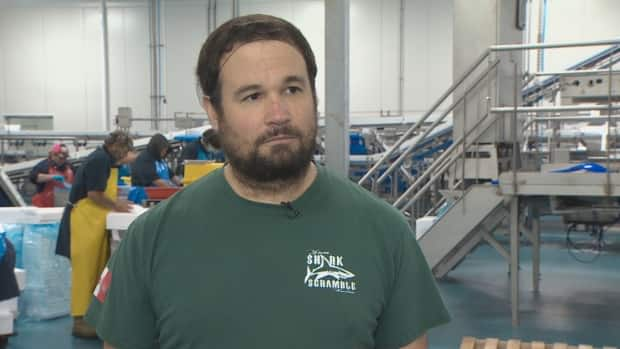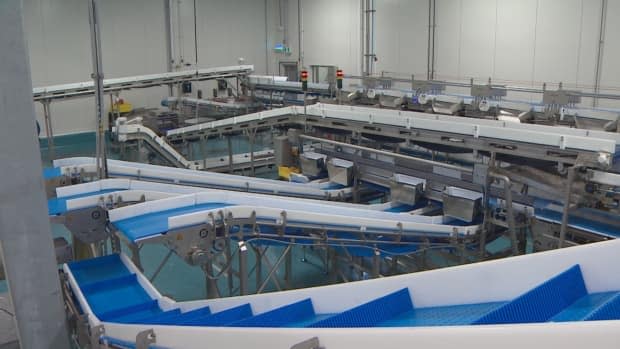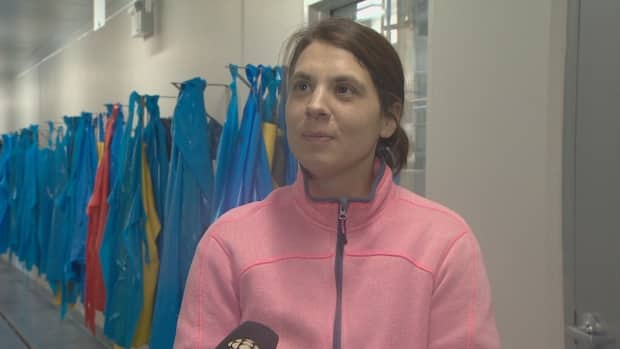'It comes back to rural Nova Scotia': Modern tech meets tradition in new fish plant

In the hands-on tradition of Atlantic Canadian fish plants, Scotia Harvest president and part owner Alain d'Entremont takes a break from a tour of the company's new state-of-the-art facility, picks up a shovel and packs ice onto halibut in a bin on a forklift.
"My grandfather would not be happy if I did not have it on the white side up. Like every halibut should be," he says, using his hands to pack the ice into the gutted cavity.
"That's for sure," chimes in Leonard Thibodeau on the forklift.
Both sport hairnets and rubber boots like the 80 other floor workers at the new Scotia Harvest groundfish plant near Digby, N.S., a blend of the old and the super high-tech.
Why this plant is special
The facility, which cost more than $15 million, went into production earlier this month. It replaced two other company plants, including one on stilts on the Digby waterfront.
The new operation features an advanced production line packed with sensors that track production through all stations.
When the whole fish starts on the line, it gets weighed and travels to get cut by hand. Scales built into the conveyors ensure the filets get to the correct end-product line without any additional handling.

"This plant was built from the ground up for process flow so that the fish doesn't stop moving when it enters the processing line and ends in the box. And that's a big change from how a lot of the plants do it, at least here in Atlantic Canada," says d'Entremont.
In a plant focused on efficiency, waste heat from the refrigeration units heat the plant floor and hot water.
The federal government provided a $3.7-million repayable contribution through its Atlantic fisheries fund. A $1-million loan came from the Atlantic Canada Opportunities Agency.
A dream come true
Built to meet international retail certification standards, the plant can process 27,000 kilograms per shift.
The main species are haddock, pollock and red fish, also known as ocean perch. The finished product ranges from restaurant-grade filets to pet food.
It's a dream come true for d'Entremont, who has worked in fish plants since he was 11 and always believed he could build a better one.
"This is my chance to prove it," the 38-year-old says.
Betting on the redfish boom
Scotia Harvest, which is co-owned by Liverpool-based Mersey Seafoods, made the investment hoping to capitalize on the exploding redfish population in the Gulf of St. Lawrence. It's estimated some four million tonnes are in the water and reaching harvest size.
"I would not be shocked if in the future we are doing primarily redfish in this plant," says d'Entremont.
Nova Scotia fish companies like Scotia Harvest hold the lion's share of redfish quota. The companies have been waiting decades for the stock to rebound.
"If we're going to be able to process the large amount of red fish that's coming in the future, we have to be able to find new markets, access them, find out what they want and deliver that product in the form that they want, whether that be individually graded pieces of fish in terms of filets or chunks or steaks or whatever that is," he says.
Keeping the workforce
Scotia Harvest employs about 100 people. D'Entremont says the company would like to add a second shift, or another 80 workers.
Like all fish plants in rural Nova Scotia, maintaining a workforce is a struggle. Average pay on the floor is around $14 an hour.
The company offers health benefits, which attracted Angela Saulnier to the job.

"I find it very important," she says. "Especially when you have kids and you have medical issues. It helps big time."
The new plant itself is also an attraction, says Sam Fralick, who works in quality control.
"I think it's really awesome. I think it's a really great opportunity for the community and for the town. I think it will draw a lot of work here," says Fralick.
A bet on the future
Specialized equipment was brought in from Iceland, including the flash freezer, but otherwise the plant was a made-in-Nova Scotia production, with some six companies involved in everything from project management to supplying the cooling system.
D'Entremont says the plant is propelling a traditional industry into the future.
"For me, it comes back to rural Nova Scotia," he says. "It was built on fish and fisheries, and we need to be able to deliver the right form. We need to be able to harvest the product and be able to pay the right price to the vessels, the captains, the crews and also be able to employ people to pack the product.
"And I think it's important that this stuff stays in rural Nova Scotia."
MORE TOP STORIES

